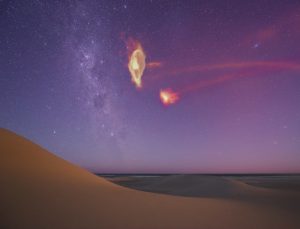
The Large and Small Magellanic Clouds are satellite galaxies of the Milky Way. They are surrounded by a high-velocity gaseous structure called the Magellanic Stream, which consists of gas stripped from both clouds. So far, simulations have been unable to reconcile observations with a complete picture of how the stream was formed. In this Nature week’s issue, numerical simulations carried out at by Scott Lucchini, graduate student at the Physics Department working with Elena D’Onghia, present a model that potentially resolves this conundrum. By embedding the Large Magellanic Cloud in a corona of ionized gas, the researchers were able to simulate the Magellanic Stream accurately and explain its structure. Ellen Zweibel and Chad Bustard are also co-authors of the article.
Read the full UW news story | Read the Nature article